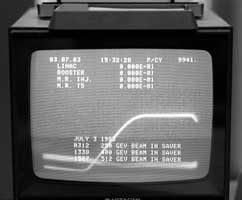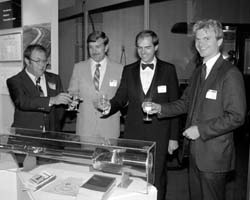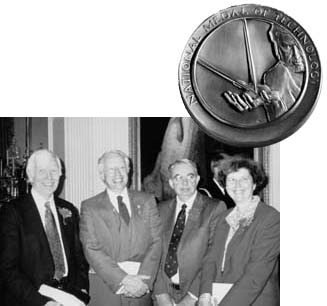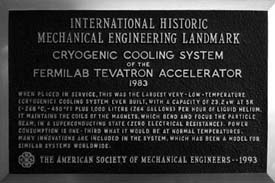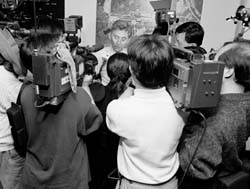 |
|
Twenty Years of Physics and Technology Achievements by Elizabeth Clements For 20 years the Tevatron has been the world's most powerful accelerator. Created by bright minds and strong hands, the award-winning design of the Tevatron has been the foundation of scientific and technological success. Many milestones highlight 20 years of achievements for the machine and the people who built and use it. July 5, 1979: DOE authorization of the Tevatron project.
May 29, 1983: All magnets cooled to below 5 Kelvin by the largest cryogenic cooling system in the world. July 3, 1983: Tevatron achieves world-record proton beam energy of 512 GeV. On February 15, 1984, the record is raised to 800 GeV. October 1, 1983: Fixed-target program begins with five experiments, initially with 400 GeV proton beam. November 10, 1983: Fermilab wins four Industrial R&D Magazine "I-R 100" awards for the most significant technical products of the year, honoring technical aspects of the Tevatron and two physics experiments.
April 28, 1984: Dedication of the Tevatron in the presence of DOE Deputy Secretary Danny Boggs, Senator Charles H. Percy, Illinois Governor James R. Thompson and other dignitaries. October 13, 1985: The CDF detector observes the first proton-antiproton collisions at 1.6 TeV. July 24, 1986: Helen Edwards wins the E.O. Lawrence Award for her leadership in the construction and commissioning of the Tevatron at Fermilab. October 21, 1986: Acceleration of protons to a new record energy of 900 GeV. CDF records the first 1.8 TeV collisions on November 30, 1986. May 1986: Tevatron named one of the Top Ten Engineering Achievements of the last 100 years by the Illinois Society of Professional Engineers.
March 26, 1987: First "new world" W boson detected at CDF. June 7, 1987: Mike Syphers graduates as the first student of Fermilab's Accelerator Ph.D. program. June 20, 1988: First collider run begins with CDF taking data. October 18, 1989: President George Bush presents the 1989 National Medal of Technology to four Tevatron scientists. April 14, 1992: The new DZero detector observes first collisions. August 31, 1992: Run I begins, the first Tevatron run with two collider detectors. May 17, 1993: Fermilab's Thomas Collins wins the Particle Accelerator Science and Technology Award for his invention of long, straight sections for synchrotron and storage rings and his design of Fermilab's accelerator lattices. September 27, 1993: Tevatron's cryogenic cooling system is named International Historic Mechanical Engineering Landmark by the American Society of Mechanical Engineers.
April 26, 1994: CDF announces the first direct evidence for the top quark. March 2, 1995: CDF and DZero announce the discovery of the top quark. Scientists worldwide sought the top quark since the discovery of the bottom quark at Fermilab in 1977. May 10, 1995: The Tevatron achieves a peak luminosity of 25E30 cm-2sec-1, the highest mark of Run I. February 20, 1996: Run I ends with a total integrated luminosity of 180 inverse picobarns. September 15, 1997: The historic 400-GeV Main Ring is shut down for dismantling. (In Run II, the Tevatron receives protons from the new Main Injector accelerator.)
January 31, 2000: After more than 40 experiments, Fermilab concludes its Tevatron fixed-target program. It led to more than 300 scientific publications and about 400 Ph.D. degrees. Future fixed-target experiments will receive beam from the Booster and the Main Injector. July 21, 2000: The DONUT collaboration, which recorded data with a Tevatron fixed-target experiment in 1997, announces the first direct evidence for the tau neutrino. August 5, 2000: Tevatron produces 980 GeV beam energy, a new world record. May 1, 2000: DZero scientist Paul Grannis, SUNY Stony Brook, receives the prestigious W.K.H. Panofsky Prize for his leadership on the DZero experiment. March 1, 2001: Run II begins with proton-antiproton collisions close to 2 TeV. July 26, 2002: Run II sets peak luminosity record of 26E30 cm-2sec-1, improving the Run I mark. March 10, 2003: Run II surpasses the total integrated luminosity of Run I, exceeding 180 inverse picobarns. March 19, 2003: The CDF collaboration submits its first Run II result for publication. August 10, 2003: The Tevatron raises the peak luminosity record to 49E30 cm-2sec-1, twice the Run I record. August 31, 2003: Since the beginning of Run II the Tevatron has produced 334 inverse picobarns—and counting. |
| last modified 11/4/2003 email Fermilab |
FRLsDFx9eyfrPXgV
